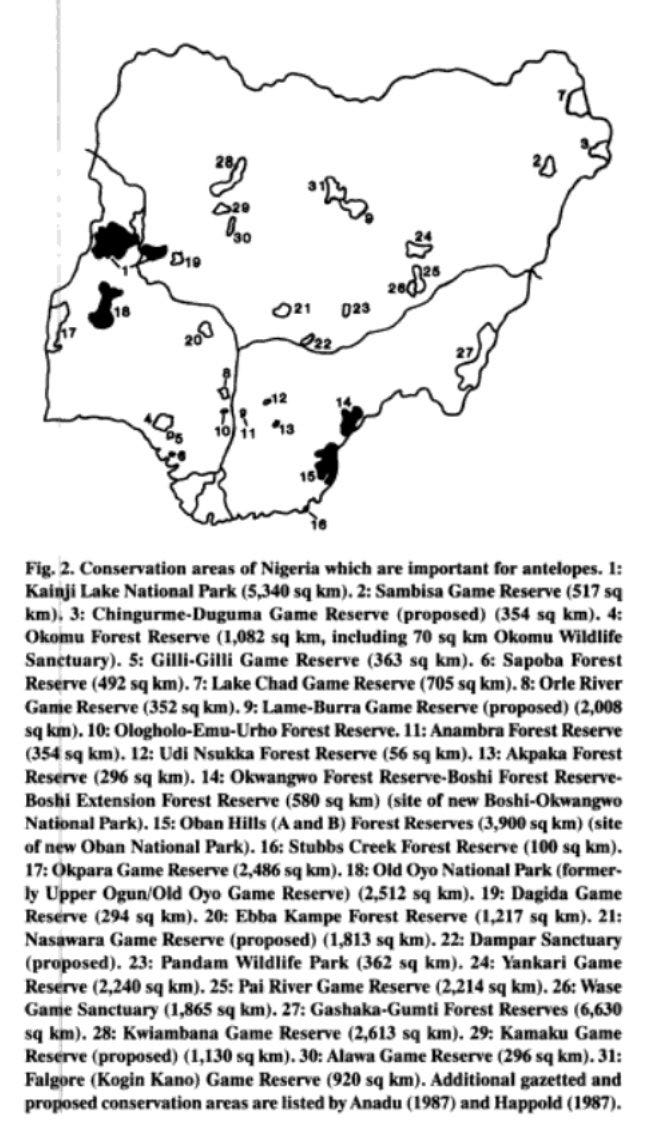Now, the Borno State I have heard about… was a Borno State of terrorism, of violence, of displacement, of despair. This is not the Borno that I found today. The Borno I found today is a Borno of hope. It’s a Borno with future…”
— United Nations Secretary General (UNSG), Antonio Guterres, May 4, 2022
FROM THE NEWS:
As reported by Leadership: “The House of Representatives on Thursday (November 2, 2023) took steps to address the invasion of marauding elephants on farm fields in Ngala and Kala-Balge LGAs of Borno State.”
THE CONTEXT:
For those who don't know, Borno State was once one home to one of the most prominent Game Reserves in West Africa: the Sambisa Game Reserve (straddling Gwoza and Bama LGAs), within the sprawling Sambisa Forest. A popular tourist destination, home to elephants (on a seasonal basis), antelopes, lions, hyenas, etc.
And then Boko Haram (and ISWAP) happened, starting from around 2009/10. Eventually (by c2013) the heart of Sambisa (“Camp Zero”) became a terrorist camp, control center, and HQ and the forest became their playing ground.
The elephants stopped being sighted in Borno State.
In December 2016, the Nigerian Military regained control of Camp Zero, and in March 2017, the Nigerian Army held its Small Arms Championship there.
In December 2019, something major happened—a sighting of a herd of ~250 elephants in Rann, Kala-Balge LGA of Borno State.
The first sighting of elephants in the area, in like a decade (i.e. since the full-blown start of the insurgency), taken from a United Nations Humanitarian Air Service (UNHAS) helicopter, and widely circulated at the time:
Radio France International (RFI) reported at the time: “Hundreds of elephants used to migrate through the region up until a decade ago at around the time Boko Haram began fighting to establish an Islamic state. In 2014, Abubakar Shekau’s faction of Boko Haram set up camp in the Sambisa Forest that was formerly a game reserve the size of Belgium and The Netherlands.” (Ok so, strictly speaking, the Game Reserve was only a small part of the Forest, around about 500 square kilometers, going by some historical documents).
Following this sighting, Kabiru Wanori, Borno State Environment Commissioner, told RFI: “It shows that peace is slowly re-emerging.”
The herd showed up again in October 2020.
Now, two years on (2023), these elephant movements are bolder and more frequent. Now, as much as it's a positive sign (testament to improved security, and to a potential future for tourism in a State that was once known as Nigeria's "Home of Peace", it's also bad for the farmers, because these elephants are now destroying farmlands, and inflicting serious economic damage to already vulnerable communities.
But it's one of those problems that progress throws up.
Terrorists are being dealt with, security situation is improving, elephants returning, but with implications for farming. It's an ongoing move, in my view, from a worse problem (terrorism) to a somewhat 'better' one (elephant invasions)—which of course also requires determined solving.
And this is where the attention from the House of Representatives is welcome.
There’s an Igbo proverb that Chinua Achebe made famous: “Let the kite perch and let the eagle perch too — If one says no to the other, let his wing break!”
Let the elephants of Borno thrive and let the farmlands thrive!
The Borno State Government and the Federal Government and all other stakeholders need to figure out how to keep the elephants, and create conditions for them to thrive, while also protecting farmers and farmlands.
One thing to always remember is that even before terrorism showed up, poaching and other forms of human activity were increasingly becoming a problem for the elephant population in Borno State. So it’s not like it was all fun and bliss for the elephants, even pre-Boko Haram.
I found this in a 2006 document, excerpted below (MIKE = “Monitoring the Illegal Killing of Elephants” Programme):
As we begin to prepare for a post-Boko Haram age in Borno, we must start planning for the wildlife as well, how they will co-exist with human populations and activity, how they can contribute to the economic revival of the region (through tourism), and how they will be protected from poaching.
It’s never too early to start thinking about these things.
REMEMBERING:
It’s always important to keep reminding ourselves of what Borno State looked like in 2014/15:
Public secondary schools in Borno were closed for about 2.5 years, starting March 2014, until October 2016
The Nigerian Air Force (NAF) was mainly operating from Yola, capital of the neighbouring Adamawa State, because Maiduguri was too dangerous (Remember the devastating attack on the Air Force Base in December 2013).
From around 2013, El-Kanemi Warriors FC of Maiduguri were forced to play “home” games in Kaduna and Katsina, until they returned home in April 2016
Maiduguri Airport was closed to commercial flights for about eighteen months, until mid-2015.
Here’s what Bama town, the second biggest town in Borno State, looked like when I visited in June 2016.
In major ‘progress’ news: Tens of thousands of Boko Haram and ISWAP fighters and their families have surrendered to the military and authorities in Borno State and North East Nigeria in recent years.
And then you have significant developments in infrastructure development, in housing, schools, healthcare, and this new power plant launched this year:
A lot has really changed for the better, and one has to be trapped in egregious denial to not acknowledge this. And yet there’s still also a long way to go. The insurgents may have been decimated, but they’re not totally gone. Hundreds of billions of naira of rebuilding needs to be done, not to talk of all the psychological trauma that must be healed from and overcome.
But the journey into the future starts with acknowledging what exists today, and how different it is from what existed seven, eight, nine, ten, years ago.
I look forward to a time when Nigerians and people from around the world will ONCE AGAIN travel enthusiastically to Borno to see and hang out with its elephants and other animals.








A lovely post
This is very insightful. Thank you very much Tolulope for sharing.